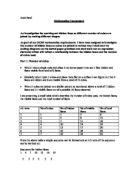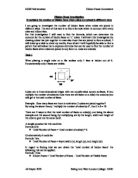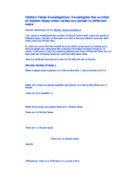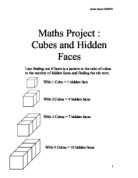- I can observe 4 hidden faces and 8 visible faces out of a total of 12 faces. I have made another diagram for 2 rows of 5 cubes laid flat on a surface.
The diagram clearly indicates that there are 36 hidden faces and 24 visible faces out of a possible 60 faces. In view of the above information I have made the following table
From the above table 2 simple sequences can be formed and an nth term of the sequence can be worked out
Sequence for hidden faces
4 12 20 28 36 44 52 the nth term for the sequence is 8n-4
8 8 8 8 8 8
Sequence for visible faces
8 12 16 20 24 28 31 the nth term for the sequence is 4n+4
4 4 4 4 4 4
- When 3 rows of 5 cubes are joined I can observe 59 hidden faces, 31 visible faces with a total number of 90 faces, the next diagram shall illustrate this.
The following table shall demonstrate the other numbers of cubes
From the above table 2 simple sequences can be formed and an nth term of the sequence
Can be worked out
Sequence for hidden faces
7 20 33 46 59 72 85 the nth term for the sequence is 13n-6
13 13 13 13 13 13
Sequence for visible faces
11 16 21 26 31 36 41 the nth term for the sequence is 5n+11
5 5 5 5 5 5
- When I join 5 cubes into 4 rows and lay it onto a flat surface I can find a total number of 120 faces with 38 of those showing and 82 hidden. The following table shows the sequence of 4 cubes.
From the table 2 simple sequences can be formed and an nth term of the sequence
Can be worked out
Sequence for hidden faces
10 28 46 64 82 100 118 the nth term for the sequence is 18n-8
18 18 18 18 18 18
Sequence for visible faces
14 20 26 31 38 44 50 the nth term for the sequence is 6n+8
6 6 6 6 6 6
- When five cubes are joined together in 5 rows I can observe 105 hidden faces, 45 showing faces with a total of 150 faces all together.
This table will show the next seven terms of the sequence
From the table 2 simple sequences can be formed and an nth term of the sequence
Can be worked out
Sequence for hidden faces
13 36 59 82 59 82 105 128 151 the nth term for the sequence is
23n-10
23 23 23 23 23 23 23 23
Sequence for visible faces
17 24 31 38 45 52 59 the nth term for the sequence is
7n+10
7 7 7 7 7 7
I have made this formula based on the above sequences which I have made by taking the height, width and the length of cuboids.
6 HWL-2HL-2HW-LW
By rearranging the above expression I have worked out the final formula for the above sequences
6 HWL-(LW+2HL+2HW)
H = Number of columns
W = Number of rows
L = Depth/nth term
Now I am going to test this formula on various shapes to testify that this formula works for any number of cubes with one column.
1. If I take 1 cube then the nth term which I made was 3n-2
And by applying the above final formula L = 1 W = 1 and H = 1
6 x 1 x 1 x 1 – (1 x 1 + 2 x 1 x 1 + 2 x 1 x 1)
6 – 5= 1 hidden face
2. I produces an nth term 8n-4 for 2 rows of cubes by applying the above formula for the fifth term of the sequence H = 1 W = 2 L = 5
6 x 1 x 2 x 5 – (5 x 2 +2 x 1x 5 + 2 x 1 x 2)
60 – 24 = 36
3. For my final example I have taken 13n-6 as my nth term which is for 3 rows of 5 cubes. H = 1 W = 3 L = 5
6 x 1 x 3 x 5 – (5 x 3 + 2 x 1 x 5 + 2 x 1 x 3)
90 – 31 = 59
Investigation for cuboids with more than 1 column
- I am starting this part of the investigation by putting 2 cubes on top of each other so as to make a column.
From the above table a simple sequences can be formed and an nth term of the sequence
Can be worked out
Sequence for hidden faces
3 10 17 24 31 38 45 the nth term for the sequence is 7n-4
7 7 7 7 7 7
- When I join 2 rows of cubes with 2 columns I can see 14 visible faces, 10 hidden faces with a total number of 24 faces
From the above table a simple sequences can be formed and an nth term of the sequence
Can be worked out
Sequence for hidden faces
10 28 46 64 82 100 118 the nth term for the sequence 18n-8
18 18 18 18 18 18
- When I join 3 rows of cubes in 2 columns using 30 cubes I can observe 133 hidden faces, 47 showing faces with 180 faces all together.
From the above table a simple sequences can be formed and an nth term of the sequence
Can be worked out
Sequence for hidden faces
17 46 75 104 133 162 191 the nth term for the sequence 29-12
29 29 29 29 29 29
- When I join 3 rows of cubes in 3 columns I will find 270 faces all together with 63 visible faces and 207 hidden faces.
From the above table a simple sequences can be formed and an nth term of the sequence
Can be worked out
Sequence for hidden faces
27 72 117 162 207 252 297 the nth term for the sequence 45n-18
45 45 45 45 45 45
Testifying the above sequences
Considering the formula used previously I am going to test the nth term made for bigger cuboids or cubes made from small cubes.
6 HWL-(LW+2HL+2HW)
1. If I take the nth term of a cuboid which I made previously as 7n-4 and test it for the fifth term then it is equal to 31. By using the general formula L = 5 H = 2 W = 1.
6 x 2 x 1 x 5 - (5 x 1 + 2 x 5 x 2 + 2 x 2 x 1)
60-29=31
2. By applying the nth term 18n-8 for the fifth term the answer comes to
18 x 5 - 8 = 82
By applying the final formula L = 5 H = 2 W = 2
6 x 5 x 2 x 2 - (5 x 2 + 2 x 2 x 5 + 2 x 2 x 2)
120 – 38 = 82
3. For my final example of a cuboid with the nth term of 45n-18 the value of the fifth term is 207 where as by applying the final formula for cuboids L = 5 H = 3 W = 3
6 x 5 x 3 x 3 - (5 x 3 + 2 x 3 x 5 + 2 x 3 x 3)
270 - 63 = 207
Evaluation
I conclude from various testing which I have conducted earlier that as the columns, rows and depth of a cuboid is altered the general formula produced will adjust itself accordingly and a true number of hidden faces can be worked out easily. This also explains the generalisations, predictions and other features considered during this assignment and strengthen the solution of hidden faces.







